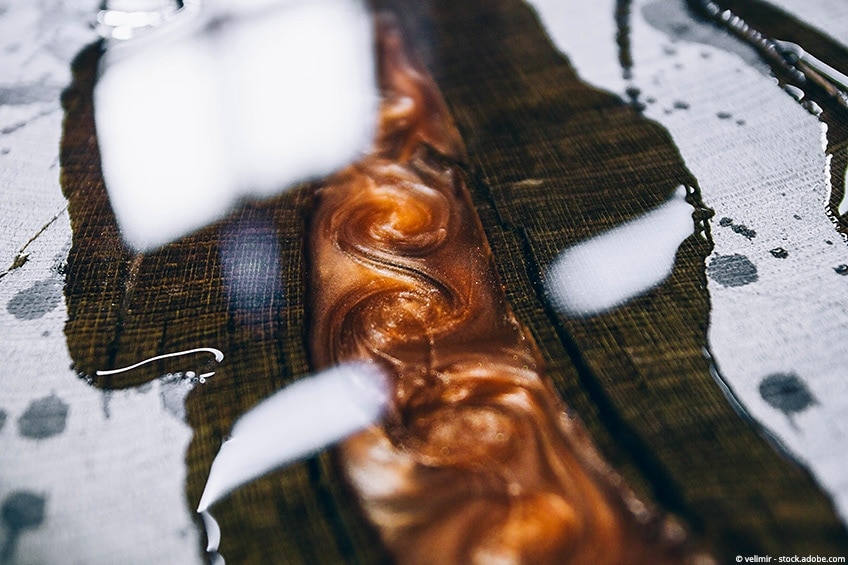So I used two-part epoxy to glue some ceramics together, and the fit is not very good. Is there anything that will soften that bond so I can pull them apart? I know that lacquer thinner can be used to remove it from fingers, and thought soaking the parts in lacquer thinner might work.
Announcement
Collapse
No announcement yet.
Is there a solvent for epoxy adhesive?
Collapse
X
-
Nothing I know of chemically will break an epoxide bond - unlike most plastics and rubbers and glued that are thermoplastic, epoxides are similar to Bakelite and Melamine in that they are thermosetting.
Mechanical means will be needed to remove/break reacted epoxy resins. Interestingly, the individual “A” and “B” components can be easily wiped off your hands and other surfaces with little effort.
“Better living through chemistry.”
-
That is some dubious chemistry there, I’m afraid.
Dried epoxy on skin is one thing, but trying to breakdown bulk epoxy (eg fiberglass resins) with these gentle liquids is fruitless.
FRP is used to store/convey acids much stronger that 5% acetic (vinegar) - and it withstands them all.
Comment
-
Sometimes I think you are a little too modest regarding your Chemist credentials. Back when I was selling industrial finishing equipment, including spray guns, pumps, booths, and entire production finishing systems, I dealt with some fairly exotic chemicals from automotive, pharmaceuticals, thick heavy sealants, and epoxies.Originally posted by NCDave51 View PostThat is some dubious chemistry there, I’m afraid.
Dried epoxy on skin is one thing, but trying to breakdown bulk epoxy (eg fiberglass resins) with these gentle liquids is fruitless.
FRP is used to store/convey acids much stronger that 5% acetic (vinegar) - and it withstands them all.
I wonder what you think about MEK? There were instances where after a demonstration of some of our equipment, we would need to take it back to the shop and clean it up. There were times when the potential customer underestimated the amount of solvent for a sufficient clean up so I would have to wait until I got to the shop to thoroughly clean up the equipment. Certain epoxy type materials would be very difficult to clean. Overnight soaking in MEK was about the only thing that would soften it enough to get the job done. Even after soaking, some of these chemical compounds required a lot of elbow grease, scrubbing, wire brushing, to clean. Nothing like you might expect from dissolving a little bit of lacquer or enamel by diluting it with mineral spirits or lacquer thinner and flushing it away.
One of the hazards of doing demonstrations was the risk of damaging expensive equipment. We had to weigh the risk vs reward. However, I think that our willingness to get dirty with our customers often made the difference in getting the business over our competitors.John Clary
Greer, SC
[SIGPIC][/SIGPIC]
SDC member since 1975
Comment
-
Love methyl ethyl ketone , it’s the bigger brother in the same family of acetone. Very strong solvent for sure, used mainly with fiberglass resin’s but it’s also an excellent auto paint “reducer”.
I always get a chuckle out of PPG or Sherwin-Williams and other companies when they charge professional shops a ton for “oil and silicone remover” as a paint prep, when in reality isopropanol does it perfectly.
I always take generous amounts of rubbing alcohol and wipe down a project car before doing any paint. Hasn’t failed me yet! Rubbing alcohol is simply a 70% version of isopropanol. With the pandemic, both of these been been hard to find since they’re also excellent sanitizers.
Comment
-
As NCDave noted, it can be difficult to impossible to separate epoxied parts. It might be helpful to know exactly what brand and type of epoxy you used. Some do have weaknesses you can exploit that may allow you to break the bond, clean up, and start over. Depends on the what you used, and what you stuck it to. We already know the latter... the glazed part should be more forgiving than the substrate.Whirling dervish of misinformation.
Comment
-
One of the Big shops I worked at, we used Formula 409, as a wax and grease remover, bought it by the 55 gallon drum. and it's cheap!
Jim[B]"We can't all be Heroes, Some us just need to stand on the curb and clap as they go by"[/B] [I]Will Rogers [/I]
[B]
We will provide the curb for you to stand on and clap![/B]
[SIZE=3][COLOR=#0000ff][B]Indy Honor Flight [I][url]www.IndyHonorFlight.org[/url][/I][/B][/COLOR][I][COLOR=#ff0000][/COLOR][/I][COLOR=#0000ff][/COLOR][COLOR=#ff0000][B][/B][/COLOR][COLOR=#0000ff][B]
As of Veterans Day 2017, IHF has flown 2,450 WWII, Korean, and Vietnam Veterans to Washington DC at NO charge! to see [/B][/COLOR][COLOR=#ff0000][B][I]their [/I][/B][/COLOR][COLOR=#0000ff][B]Memorials! :!:[/B][/COLOR][/SIZE]
Comment
-
-
Occasionally in my career in electronics design, we'd have to send in damaged ICs or transistors from test failures, etc. to the manufacturer for analysis. These parts are basically encapsulated/molded in a black thermoset type material. The suppliers have lab facilities to dissolve this material to get down to the bare silicon chips and wire leads and bond wires. I have heard its pretty nasty. The analysis lab we have at work won't deal with it and we generally stick to x-raying and other types of analysis before sending it out.
Sometimes we have potted boards and I wish there was something to dissolve that potting that won't also dissolve everything else! Have to resort to mechanical means.[SIGPIC][/SIGPIC]
Jeff in ND
Comment

Comment